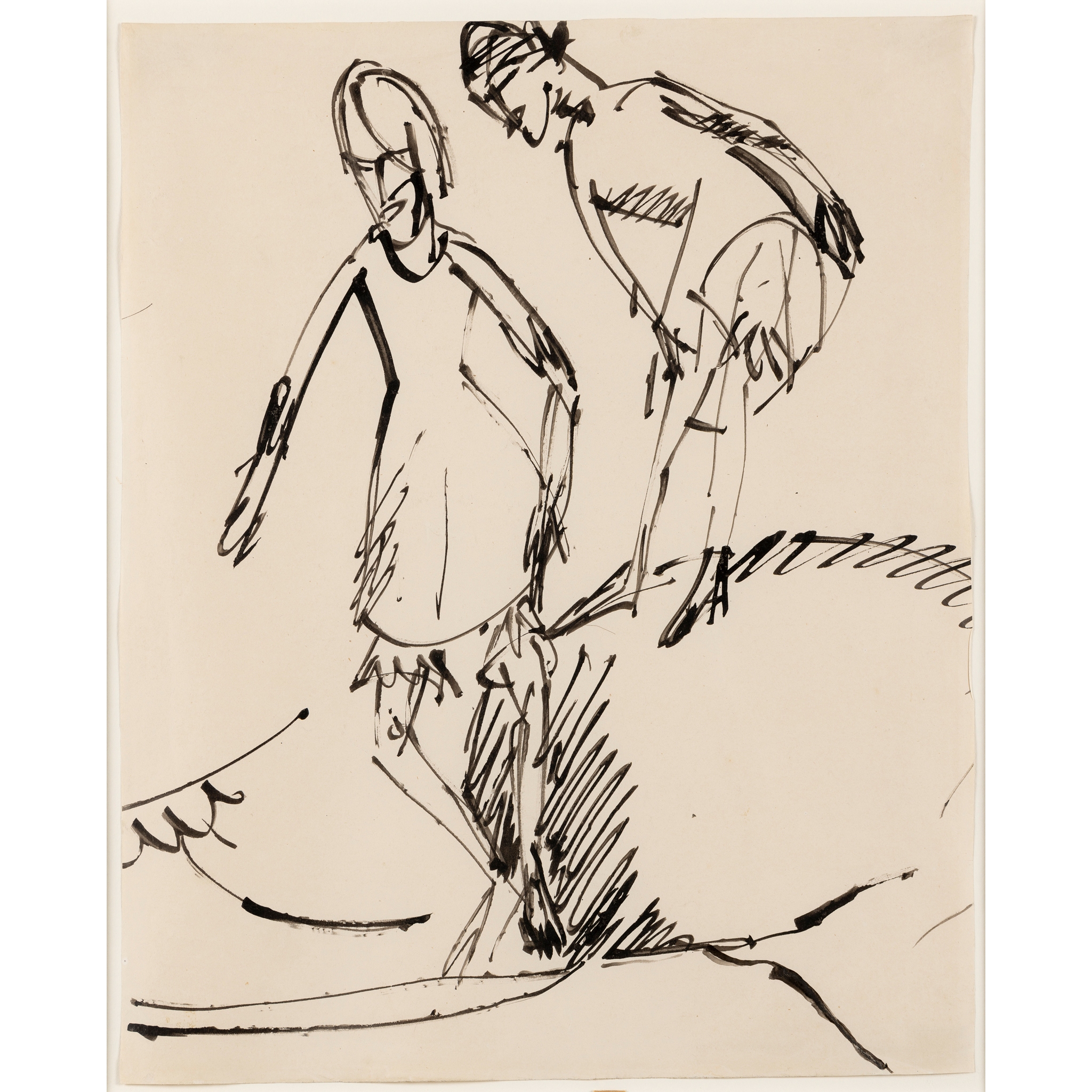ERNST LUDWIG KIRCHNER (GERMAN 1880-1938)
ZWEI MÄDCHEN [TWO GIRLS], c. 1925
Estimate: £8,000 - £12,000
Auction: The Gillian Raffles Collection Evening - Lots 1 to 73 - Thursday 01 May at 18:00
Description
stamped with the Nachlass E. L. Kirchner mark and numbered F Be/Bh 4 in ink and K4535, 4167 and C-1241 in pencil (to reverse), Indian ink on paper
Dimensions
46cm x 36.5cm (18 1/8in x 14 3/8in)
Provenance
The Collection of Gillian Raffles.
Footnote
This work is listed in the Ernst Ludwig Kirchner Archives, Wichtrach/Bern and will be included in any forthcoming catalogue raisonnés of the artist's graphic works.
‘I learnt to value the first sketch, so that the first sketches and drawings have the greatest worth for me. How often I’ve failed to pull off and consciously complete on the canvas that which I threw off without effort in a trance in my sketch…’
Ernst Ludwig Kirchner, ‘Zebdher Essay’, recorded in his diary, 1927
Ernst Ludwig Kirchner’s Zwei Mädchen is the perfect expression of the ‘modernist primitivism’ that defined German Expressionism in the early 20th Century, both that of the Die Brücke group (of which Kirchner was the founder and leading light) and its Munich counterpart, Der Blaue Reiter, led by Kandinsky. Both groups sought to free art – and life – from the shackles of bourgeois ideals and (in art) stifling Academism, alighting upon the cultures of non-European peoples as ciphers of a more direct and intuitive emotional ‘truth’, in particular the art of the Pacific (inspired by Gauguin) and of Africa. Whilst today we would look at the Expressionists’ approach to non-European art as a form of cultural appropriation, based on fundamental misconceptions of this art being ‘primitive’ rather than highly sophisticated in its own right, this approach was, at least, wholehearted in its intention: Kirchner and his contemporaries were genuinely looking to the non-European for something lacking in the West, their ‘primitivism’ beyond a mere imitation – rather a search for authenticity, a direction of travel to express true modernity.
In Germany in the early part of the century, modernity was inextricably tied up with youth and the young, who, like their ‘primitive’ counterparts, were seen to be free from convention and bourgeois concerns. In Zwei Mädchen we see Kircher giving expression to this idea in the girls’ angular, un-selfconscious poses – and their evident Nietzschean energy. The space in which they stand is less easy to read, but they could be on the banks of a lake, peering in. The great outdoors was another key modernist space, wild and unbounded: the 1920s in Germany was the era of freikorperkultur – ‘free body culture’ – an idea that starts in the wider sense as nudism, but extends, within avant-garde circles, to encompass wild camping, free love, improvisational dancing and prototypical ‘happenings’.
In Zwei Mädchen, Kirchner shows his mastery of brush and ink, which perhaps could be said to be the medium of German Expressionism. The brush allows for bold, jagging lines and an emphasis on outline over shading, as sculpting the figures on paper as they would with chisels out of wood; and the ink allows for speed – an idea as modern as modern can be. Brush and ink allows spontaneity, a definitiveness of gesture, that Kirchner, Heckel and fellow members of Die Brücke honed in their ‘quarter-hour’ life drawing sessions, where working quickly became analogous to working without premeditation – or as Jill Lloyd puts it, speed of execution becomes an ‘attempt… to catch modernity on the wing’. (Jill Lloyd, German Expressionism: Primitivism and Modernity, Yale University Press, New Haven & London, 1991, p.45)

